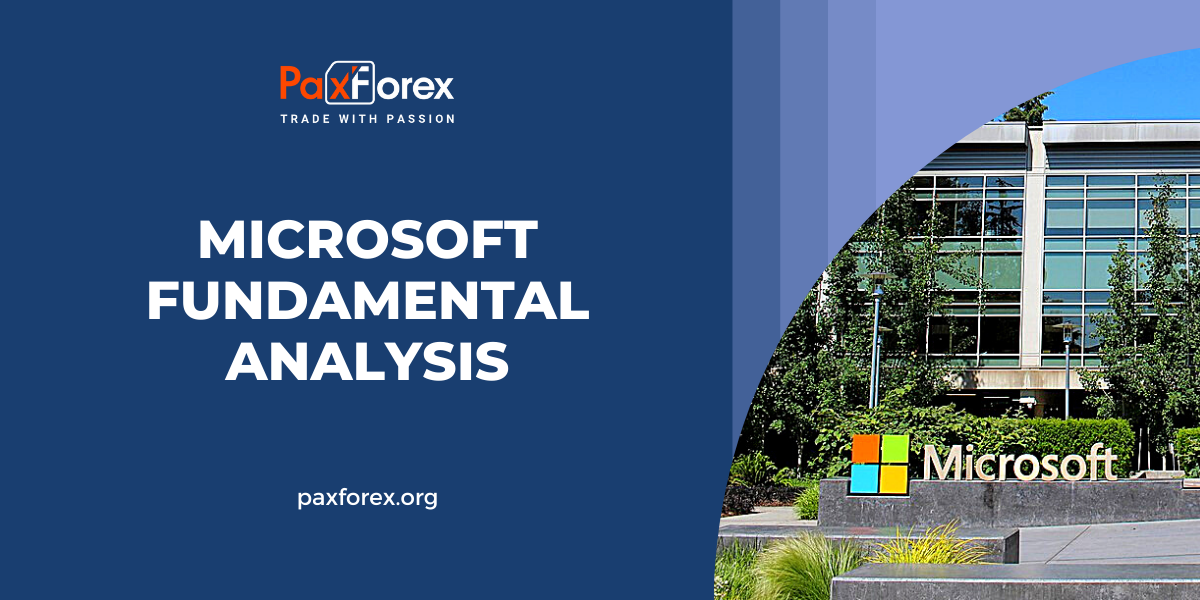
Source: PaxForex Premium Analytics Portal, Fundamental Insight
Microsoft and Apple have become fast-growing companies again under the leadership of visionary CEOs. Taking the helm at Microsoft in 2014, Satya Nadella set a new course for the company, expanding its cloud services and reducing its dependence on desktop software. Microsoft developed more mobile apps for iOS and Android, launched new Surface devices, expanded its Xbox gaming business, and abandoned the troubled Windows Phone platform.
Apple stagnated for several years until Steve Jobs took over the company in 1997. Jobs' work, which continued until his death in 2011, led to the destruction of the PC, digital media player, smartphone, and tablet markets through the iMac, iPod, iPhone, and iPad. Jobs' successor, Tim Cook, continued to grow Apple's hardware business with the Apple Watch, AirPods, and HomePod while expanding its ecosystem of services.
Microsoft and Apple generated huge returns for investors who believed in this transformation. Since Nadella's first day on the job, Microsoft stock has risen about 570%. Meanwhile, Apple stock has soared 78.770% since Jobs returned as CEO.
Over the past few years, the market value of both tech giants has surpassed the $1 trillion mark. Microsoft's valuation exceeded Apple's many times during this rise, but Apple's current market capitalization of $2.5 trillion is now well ahead of Microsoft's $1.8 trillion valuation. Could Microsoft catch up with Apple again in the next few years?
Microsoft gets most of its revenue from software and cloud services, while Apple makes most of its money from hardware sales. The key metric for Microsoft is cloud computing revenue, which in the fiscal year 2022 (which ended in June) grew 32 percent to $91 billion, or 46 percent of total sales. That segment includes Office 365, Dynamics, and Azure, the world's second-largest cloud infrastructure platform after Amazon Web Services (AWS). Recently, it has managed to compensate for the slowdown in its desktop software and Windows licenses.
As for Apple, most investors are tracking iPhone sales, which brought in 54% of the company's revenue for the first nine months of fiscal 2022 (which ended in June). They're also keeping a close eye on service revenue, which accounted for 19% of total revenue during that period and reached more than 860 million paid subscriptions at the end of the third quarter. Bulls believe that the growth of the services ecosystem will put users in Apple's "kitchen garden" and gradually reduce its dependence on the iPhone.
Microsoft's business is more diversified than Apple's. The Surface and Xbox businesses are cyclical, but these two hardware divisions are much smaller than the core software and cloud services segments. Meanwhile, Apple's growth is still heavily dependent on tight hardware refresh cycles, which gradually lengthen with each generation of faster devices. In addition, the company is more exposed than Microsoft to chip shortages, supply chain disruptions, tariffs, and rising labor costs.
That's why analysts expect Microsoft revenue to grow at a compound annual growth rate (CAGR) of 13% from fiscal 2022 to 2025, while Apple revenue will grow at a compound annual growth rate of 5% from fiscal 2021 to 2024. They also expect Microsoft's earnings per share (EPS) to grow by 13% over that period. On the other hand, they expect Apple's EPS to grow at an annualized rate of 7%.
We have to consider these estimates with some doubt, as they probably do not take into account Microsoft's plans to aggressively expand its gaming business through new acquisitions or Apple's long-discussed AR and VR devices. However, they clearly indicate that Microsoft's cloud business will continue to thrive as Apple's hardware sales cool off again.
Based on these expectations, Microsoft stock should trade at a premium to Apple stock. However, Microsoft stock is trading at a 25x earnings forecast, while Apple has a slightly higher price-to-earnings ratio forecast of 26x.
One could argue that both stocks were overvalued because of the flight to safer blue-chip tech stocks during the ongoing bear market, but investors also seem to be pricing Apple stock in the value of many rumored products, including AR gadgets and driverless cars. So Apple stock probably deserves to trade at a lower multiple than Microsoft. If these valuations change over the next few years, Microsoft could well become more expensive than Apple by 2025.
As long as price is below 249.00, follow the recommendations below:
- Time frame: D1
- Recommendation: short position
- Entry point: 237.87
- Take Profit 1: 230.00
- Take Profit 2: 225.00
Alternative scenario:
If the level of 249.00 is broken-down, follow the recommendations below:
- Time frame: D1
- Recommendation: long position
- Entry point: 249.00
- Take Profit 1: 260.00
- Take Profit 2: 266.00













